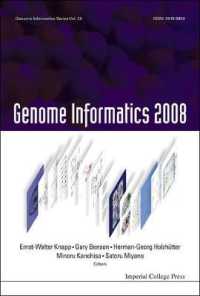- ホーム
- > 洋書
- > 英文書
- > Science / Mathematics
基本説明
Table of Contents- Learning to Read the Oceans: Genomics of Marine Phytoplankton
(Tatiana A. Rynearson and Brian Palenik). Biology of Deep-Water Octocorals
Les Watling, (Scott C. France, Eric Pante, Anne Simpson). Tipping points, thresholds, and the keystone role of physiology in marine climate change research (Cristián J. Monaco and Brian Helmuth). Social aggregation in the pelagic zone with special reference to fish and invertebrates (David A. Ritz, Alistair J. Hobday, John C. Montgomery, Ashley J.W. Ward).
Full Description
Advances in Marine Biology has been providing in-depth and up-to-date reviews on all aspects of marine biology since 1963 -- over 45 years of outstanding coverage! The series is well-known for both its excellence of reviews and editing. Now edited by Michael Lesser, with an internationally renowned Editorial Board, the serial publishes in-depth and up-to-date content on a wide range of topics that will appeal to postgraduates and researchers in marine biology, fisheries science, ecology, zoology, and biological oceanography.
Contents
Part 1. Learning to Read the Oceans
1. Introduction
2. Marine Cyanobacterial Genomics
3. Eukaryotic Genomics
4. Conclusions Acknowledgements
Part 2. Biology of Deep-Water Octocorals
1. Introduction
2. Classification
3. Phylogenetic Relationships
4. Biogeography
5. Distribution of the Three Major Deep-Sea Families
6. Symbionts
7. Predators
8. Food
9. Reproduction
10. Growth and Age
11. Dispersal
12. Threats and Conservation Issues Acknowledgements
Part 3. Tipping Points, Thresholds and the Keystone Role of Physiology in Marine Climate Change Research
1. Introduction
2. Weather, Climate and Climate Change from the Viewpoint of a Non-Human Organism
3. Physiological Response Curves
4. Indirect Effects of Climate Change: Species Interactions and Tipping Points
5. Putting the Pieces Together: Where Do We Go from Here? Acknowledgements
Part 4. Social Aggregation in the Pelagic Zone with Special Reference to Fish and Invertebrates
1. Introduction
2. Aggregation Principles and Features in Pelagic Ecosystems
3. Technology Breakthroughs in Experimental and Observational Methods
4. Theoretical Developments in Social Aggregation
5. Social Aggregation, Climate Change and Ocean Management
6. Conclusion Acknowledgements








